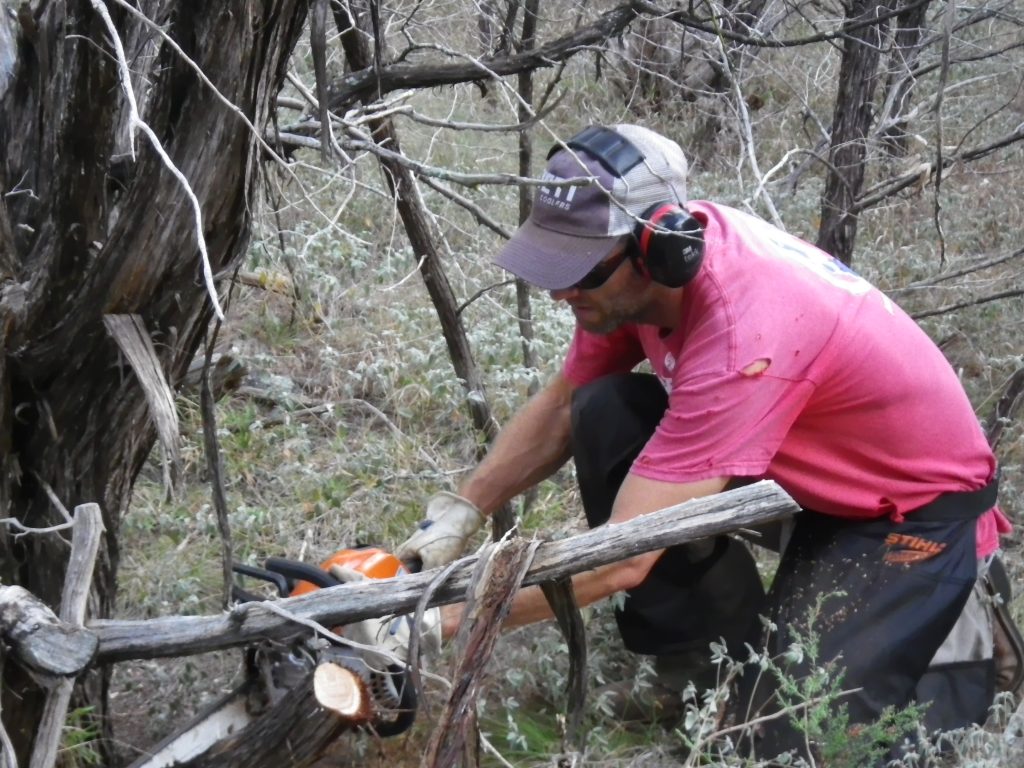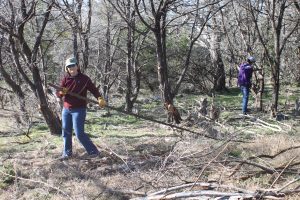

A Travis County Audubon Society Project
Funded by Audubon Foundation of Texas
The drought of 2011 caused a great deal of tree mortality at Baker Sanctuary and throughout the larger Balcones Canyonlands Preserve. At Baker a large swath of mostly Ashe Juniper, some 15 acres in size, succumbed to the drought. To manage the dead trees, a few factors had to be taken into consideration. As a preserve for the Golden-cheeked Warbler (GCWA) any land management must not negatively impact this endangered species. Luckily, GCWA do not utilize stands of dead wood, they tend to avoid them like the plague. They prefer closed canopy Ashe Juniper/oak woodlands which provide some degree of cover from roaming raptors. To avoid disturbing the GCWA, any large-scale work such as felling trees would have to wait for the fall/winter when the GCWA are hanging out in their mixed species foraging flocks in Central America.
After an experience with a pickup truck that caught fire in the right-a-way directly adjacent to the immense stand of dead wood and concern about Pedernales Electric Coop powerline as another source of possible ignition, it was clear that 15 acres is a lot of dead wood and it would have to be targeted strategically. With that in mind, Travis Audubon applied for and was awarded $1000 for a fire hazard abatement project.
With funds from the grant a Stihl MS211 chainsaw was purchased ($310) and several volunteer days were organized. On January 23 twelve volunteers, armed with pruning saws and loppers (as well as the steward with the chainsaw) descended on the five acre swath of dead Ashe Juniper located at Gate 12424. It soon became very apparent for safety as well as time constraint issues that cutting all the dead trees out would not be feasible. Instead the strategy shifted to cutting out select trees, removing old brush from the ground, and pruning up standing deadwood to the height of six feet. With the lower limbs and brush gone a low-intensity ground fire should not be able to gain access to the canopy and become a destructive crown fire. In total forty-two volunteer hours were spent cutting, pruning, hauling, and stacking deadwood to be chipped the following week. On January 27 a chipper was rented from Home Depot ($273.75) and the steward as well as four volunteers spent a total of 21.5 hours chipping an estimated forty cubic yards of slash. The mulch from the chipper was sprayed to a depth of about two inches in the area immediately adjacent to the road. The layer of mulch would keep grasses from growing (invasive KR Bluestem being the prevalent species in the area) and therefore impede fire from moving deeper into the forest or up into the canopy.
In addition to the work completed in the Gate 12424 area, the steward spent the fall and winter selectively cutting down and removing dead trees on the other side of the road where they impeded access, posed a danger to hikers, or were in a high ignition risk area. On January 2, a chipper was rented ($273.75) and with the help of one volunteer a total of 16 hours were spent chipping the estimated fifty cubic yards of slash. Mulch generated during chipping was piled and stored for later use on the sanctuary. Other incidental purchases associated with the project included gasoline for the chipper ($10), a new pruning saw ($21.98), and a spare chain for the Stihl ($20) for a total of $090.48 spent on the project. This does not include the cost of gasoline and oil for the chainsaw.
Selectively trimming the area near Gate 12424 and areas south have bought some time to raise funds and consider how to handle the rest of the fifteen acre swath, affectionately known as the Dead Zone. Travis Audubon is currently looking into various management options which weigh the needs of regenerating juniper, the safety of the adjacent neighborhood, and budget constraints. Many thanks to ATF for buying us some breathing room!